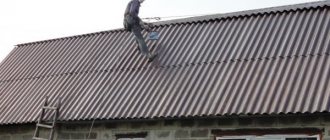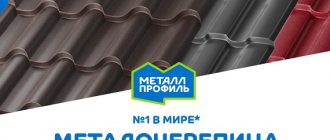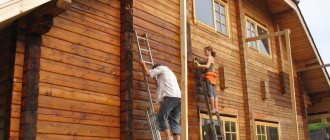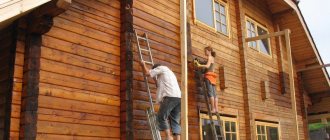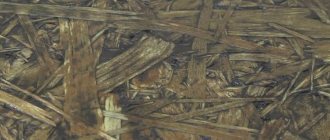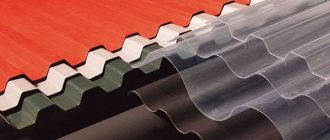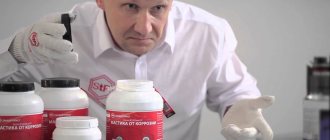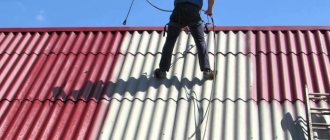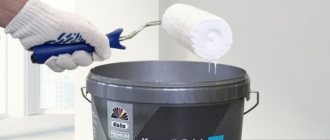Slate is a durable, inexpensive, reliable and time-tested roofing material. Even today, with all the variety of finishing materials, it continues to be in demand. However, its big disadvantages are its gray, dull appearance and porous structure. But with the advent of new paints and varnishes, these flaws can be easily corrected. Paint for slate will not only improve the appearance, but also extend the service life of the material.
To ensure that the roof serves faithfully for many years, and the enamel does not peel off and “bubble” in the first season, it is important to choose the right paint for slate. Our article will help you with this.
Why do you need to paint slate?
With the help of simple painting technology, it is easy to give a nondescript slate roof a spectacular bright look by choosing a color that matches the overall design of the building. However, paint on slate solves not only aesthetic problems.
The main problem with slate is its porous surface, which fades over time, becomes clogged with dirt, microcracks form and its structure is destroyed. Water gets into the cracks, mold forms, mosses and lichens grow, penetrating into the body of the material. In addition, unpainted slate releases tiny asbestos chips into the atmosphere, which are toxic and dangerous to human health.
The paint coating forms a thin, durable, moisture-resistant film on the outer surface of the material, which significantly improves its technical characteristics and service life:
- The paint fills the pores of the material, making it stronger and smoothing out the microrelief.
- After painting, the moisture-proof properties of the roof increase, and it suffers less from temperature changes.
- Protects slate from contamination and clogging of pores with dust.
- Protects the material from the growth of mold and moss, which destroy its structure.
- Increases the environmental friendliness of the roof by creating a protective coating that minimizes the release of asbestos dust into the atmosphere.
Types of paints for slate
Painting slate with the wrong material is not advisable. The coating will swell and begin to bubble within the first year. Asbestos fibers are not compatible with all types of paints. The following types of products for staining slate are distinguished:
Water-based acrylic paints
Water-dispersion paints are widely used, are easy to use and significantly improve the performance of slate roofing. An extensive range of products with varying degrees of matte finish and a wide range of colors will help you choose a coating to suit every taste. The functions of the solvent here are performed by water.
Distinctive characteristics:
- easy to apply, do not smear, dry quickly;
- fireproof, environmentally friendly, characterized by the absence of a pungent odor;
- create a reliable moisture-proof coating;
- increase resistance to temperature changes;
- no solvent required;
- The service life of acrylic coating is about 5 years.
Water-based acrylic paints for slate are affordable.
Water-based acrylic compositions also include paint, which is called “rubber”. The components remain the same, only the structure of the material is very thick and similar to mastic. This composition applied to the roof forms an elastic and very flexible film. This universal material is used not only for painting roofs, but also for covering swimming pools, showers, treadmills, and various anti-slip structures.
Acrylic paints based on organic solvents
A type of acrylic paint, however, not water, but special organic solvents are used as a thinner. I usually use white spirit. This type of coating differs from water-dispersion coating by increased strength, elasticity and higher hydrophobic properties. This paint does not fade for a long time and retains its original color.
However, when painting, it is worth considering that the paint has a pungent odor, which gradually dissipates, and the drying time of one layer is about 12 hours.
Organosilicon (silicone) paints
Silicone paints are a composition of dyes and various additives in a silicone binder. This roof covering is considered one of the most reliable and durable, has increased elasticity and water resistance. The enamel permeates the top layer of the material, actually providing an additional protective coating to the roof, filling cracks up to 0.2 cm. It provides the roof with a deep, long-lasting color that does not fade or fade in the sun.
Silicone paints are applied only to dry surfaces
Properties of silicone paints:
- fire safety, no pungent odor;
- increased strength and elasticity;
- high frost resistance and hydrophobicity;
- dirt-repellent properties, enamel also prevents the proliferation of mosses and lichens in the pores of the material;
- does not require surface priming;
- service life is about 10-15 years.
Alkyd slate paints
Alkyd enamels for slate contain alkyd resins in addition to pigments and additives. This coating has good adhesion to the roofing material and a short drying time (about 1 hour). The paint forms a durable elastic film that is resistant to external influences and cracking. The enamel has increased moisture resistance, frost resistance and protects the slate from contamination. Another positive quality is that it does not require priming the surface before application. The durability of the coating is about 5 years.
Polymer paints “Liquid plastic”
Polymer-based enamel contains components such as polyurethane, vinyl or polystyrene, due to which, after drying, it forms a thin but durable plastic layer on the roofing material. “Liquid plastic” is hydroscopic and completely eliminates the penetration of not only moisture, but also mold or mildew. This paint is very wear-resistant and reliable, the color does not fade or fade under the influence of ultraviolet radiation for a long time.
Properties of “liquid plastic”:
- hydroscopic and resistant to sub-zero temperatures (allows application at temperatures down to -10°C);
- fire safety and environmental friendliness;
- quick drying;
- does not require special preparation of the surface with soil;
- The durability of such coating is up to 15 years.
The price of such compositions is quite high, but the characteristics and service life of the coating justify the costs.
No. 2. Advantages and disadvantages of slate
We have already understood that painting slate generally has a positive effect on its properties. However, since we said that this roofing material has a number of advantages over some analogues, it would not be amiss to list them. And among the main ones it is worth highlighting the following:
- high strength due to the successful combination of asbestos with cement;
- does not rust, does not conduct electricity;
- resists moisture well and does not heat up as much in the sun (like metal);
- can last much longer;
- much more affordable price compared to analogues.
Of course, it also has a number of other positive features, such as good sound insulation or the absence of toxic emissions during combustion, but these are no longer so important features for many consumers. Frankly speaking, slate also has its drawbacks , which are worth mentioning for the sake of objectivity. Fortunately, there are not many of them, and they are expressed in rather heavy weight (one sheet of slate weighs about 18 kg), and also in the fact that despite its high strength, slate can be extremely fragile. It will not be difficult to damage it during careless transportation or installation.
Manufacturers, prices and variety of colors
The most common colors for painting roofs are red, dark brown, and green, but the color range of most paints is extremely diverse. In addition, for individual color selection, many manufacturers of paint and varnish products provide possible tinting options. Tinting can be done independently using tinting paste or using specialized equipment.
It is better to tint the entire volume of paint at once to achieve a uniform shade. When tinting again, it will be very difficult to achieve the desired shade.
The most famous composition is the slate paint “Shikril” from. It belongs to a variety of acrylic compositions based on organic solvents and can also be used for painting concrete and cement-sand surfaces. The color scheme is not very diverse, but the basic colors are present. It is characterized by low cost and economical consumption. The average price is 250-300 rubles per kg.
"KILPI" is another acrylic composition for slate surfaces from the famous one. Can be used for most types of roofing materials: flat slate, tile roofs, roofing felt, fiber boards. The consumption of such enamel is quite high - per 2 square meters. meter requires approximately 1 liter of solution.
Novbytkhim roofing paint is suitable for painting used and new roofing materials. The enamel is resistant to fading, weathering, moisture-resistant and prevents the formation of mold and lichen, giving the roof a neat and modern appearance. The operating time in the climate of central Russia is at least five years. The average price is 200-300 rubles per kg.
Polyfarb is a water-dispersion paint from a Polish manufacturer. It is characterized by quick drying and has a rich palette of colors. The composition is characterized by excellent hydroscopicity and resistance to fading in the sun.
Paint consumption and surface care
Rubber paint is economical. The cost of liquid material depends on the type of base. For example, to process galvanized or iron sheets you will need about 250 g per 1 sq.m. For concrete, brick and plastered surfaces, about 400 g are required, and for wooden surfaces - 350 g. For slate, 450 g are required, and if the base has been previously painted, then only 150 g is consumed.
Wet cleaning of the surface can begin a week after it has dried. During this time, the layer of rubber paint acquires the necessary properties. Chemical aggressive compounds cannot be used.
Slate coloring technology
When painting slate with your own hands, you should adhere to the basic rules and follow the painting technology.
The easiest way to work is with a new roof. If the roof has been covered for quite some time, the surface should be thoroughly cleaned of dirt and possible vegetation. To do this, you can use a metal wire brush. The cleaned surface must be washed with water and then inspected for cracks. Any deficiencies found should be carefully repaired with a mixture of asbestos, cement and PVA glue. After complete drying, the surface should be primed.
Surface primer
Primer treatment is necessary not only for better adhesion of the enamel to the surface layer of the roof, but also to save enamel. In addition, without the use of a primer, the color of the roof may be uneven. It is better to treat the old roof several times. It is convenient to prime slate using a wide brush or sprayer. To paint flat slate on the facade of a house, you can use a roller.
Painting
Before painting, wait until the primer is completely dry. The paint is applied in two layers. The first layer is the base layer, which should be applied especially carefully, painting all surfaces and parts of the roof. The second layer is the final one, it is applied to achieve a uniform coating without streaks or imperfections. A second coat should be applied after the first one has completely dried.
If new slate is being painted, it is easier to carry out this procedure before laying the material and attaching the already painted one. You can apply the paint with a brush, roller or spray gun.
Compliance with all stages of painting and a deliberate choice of high-quality paint and varnish material will give the ordinary nondescript material not only a neat appearance and color, but will also allow the material to serve for many years.
Last year I painted the slate roof of the house. I chose acrylic enamel. Heard a lot of great reviews. So far there are no complaints about the quality. The color is bright, it has not cracked or peeled over the winter. I would like to recommend Shikril paint. An excellent paint for slate, not difficult to use and has very good water-repellent and frost-resistant properties. It fits well on wavy surfaces and is economical when painting. The price is also optimal.
Preparing slate for painting
It is absolutely possible to paint even the slate that is already on your roof. If such a roof was installed quite a long time ago, then we can say with 100% certainty that moss has formed on it, especially on the north side of the house.
Naturally, you cannot immediately apply paint to such slate. First you need to remove all dirt and the moss itself. And this can be done in several ways:
Mechanical method. Using iron brushes to remove moss from the slate surface. To facilitate this work, the slate is moistened with water. This method is the most labor-intensive and least effective in its application.
You can use a drill with a special iron brush for this method, but without using water.
The best way to remove moss from a roof is to remove it with a washing machine (regular household mini-washers such as Karcher). With the help of strong water pressure, moss and other natural phenomena seem to be cut off from the roof surface. After cleaning using this method, the slate needs to dry. The next step will be to inspect the slate and replace damaged sheets with new ones.
